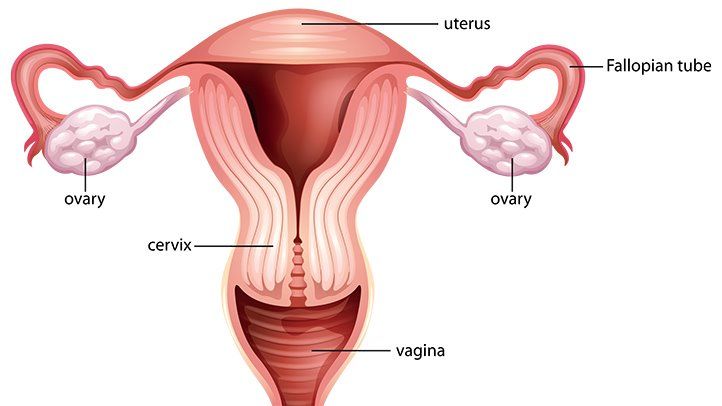The uterus is a hollow central supporting organ of the pelvic anatomy and pear-shaped internal genitalia.
Female Reproductive Tract: The uterus.
The female reproductive tract consists of the uterus, which is a pear-shaped, thick-walled, muscular organ located in the center of the pelvis, behind the bladder, and in front of the rectum. In fact, the uterus contains some of the strongest muscles in the female body. At the bottom of the uterus is the cervix, which is continuously connected to the vagina.
Female Reproductive Tract: The vagina.
Below the cervix is the vagina, and which is a flexible tubular structure that connects the internal and external reproductive organs. So the vagina is a muscular hollow tube that extends from the vaginal opening to the uterus. Also, we can describe the vagina as a fibromuscular tube that extends from the vulva to the uterus and is inclined at an angle of about 60° to the upward and backward horizontal lines. The vulva is located between the legs and covers the opening of the vagina and other reproductive organs of the body.
Female Reproductive Tract: The openings for the urethra
Between the lips are openings for the urethra (the channel through which urine from the bladder flows out of the body) and the vagina. They are located inside the labia majora which surrounds the vagina, which is the canal that connects the lower uterus to the outside of the body, and the urethra (the tube that drains urine from the bladder outside the bladder). In other words, the labia majora forms the inner protective layer of the female genitals.
They attach to the uterus through the ovarian ligaments and to the broad ligament through the mesovarium, which is the peritoneal ligament.
Female Reproductive System: The ovaries
The ovaries are two oval-shaped organs located in the upper right and left corner of the uterus. The ovaries’ main functions are the production of eggs and sex hormones. Most women have two ovaries, one on each side of the uterus. At birth, the two ovaries contain about 700,000 oocytes, which are immature eggs.
Reproductive Hormones.
Hormones stimulate the growth of approximately 15-20 eggs in the ovaries. Each egg has its own “shell” called a follicle. Also, these hormones (FSH and LH) also cause an increase in the production of the female hormone estrogen. The secretion of these hormones enables girls to grow into sexually mature women.
Women of reproductive age which means between 11 to 16 years old and up experience cycles of hormonal activity that repeat at approximately one-month intervals. As a result with each cycle, a woman’s body prepares for a potential pregnancy, whether or not she intends to.
In humans, the female reproductive system is immature at birth and matures during puberty. Then becomes capable of producing gametes and conceiving fetuses before term. The female reproductive tract is composed of internal and external reproductive organs, which play a role in the reproduction of new offspring. The uterus or uterus is an important female reproductive organ that responds to hormones in most mammals including humans.
The reproductive system and the impact on general health.
The reproductive organs also have a significant impact on other aspects of health. For example, the ovaries produce hormones that affect bone density, cholesterol levels, heart health, and mood. The female reproductive organs are made up of several key structures such as the ovaries, uterus, vagina, and vulva. These organs are involved in fertility, conception, pregnancy, and childbirth.
The female internal reproductive organs.
The female internal reproductive organs are the vagina, uterus, fallopian tubes, and ovaries. The internal reproductive tract, including the female reproductive system is divided into external genitalia and internal genitalia. The reproductive tract (or reproductive tract) is a lumen. It begins as a passage through the vagina and is divided into two lumens in the uterus. Both of these lumens pass through the fallopian tube and open to the distal end of the abdominal cavity. Finish.
The fertilization
If you had intercourse and the man’s sperm fertilizes an egg (a process called conception), then your fertilized egg (embryo) will pass through the fallopian tube and be implanted into the uterus. Where the lining of the uterus thickens in response to normal reproductive hormones and continues to develop.
In this small amount of sperm, millions of sperm “float” from the vagina through the cervix and uterus to meet the egg in the fallopian tube. When the fetus is mature enough to survive outside the uterus, the cervix expands. As a result and the uterine contraction pushes the baby through the birth canal (vagina).
